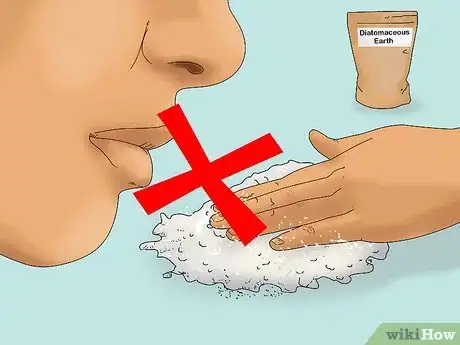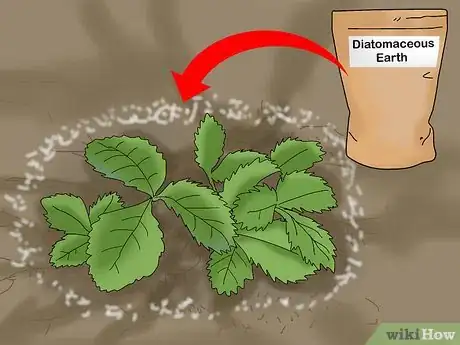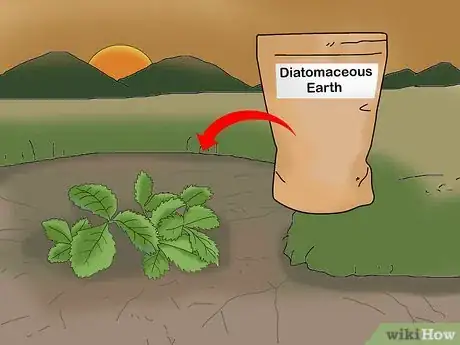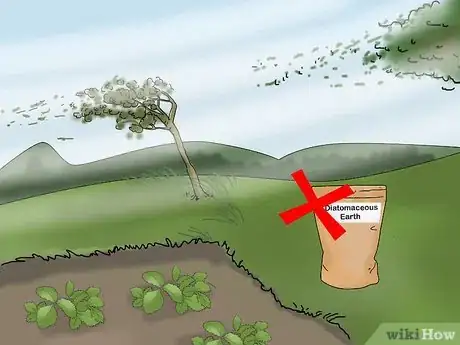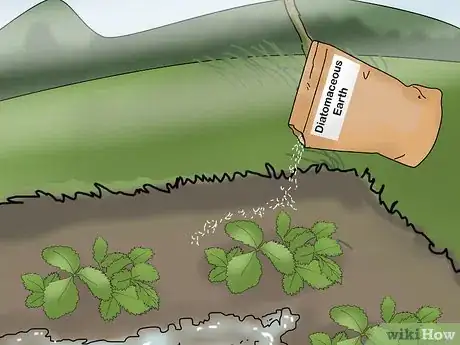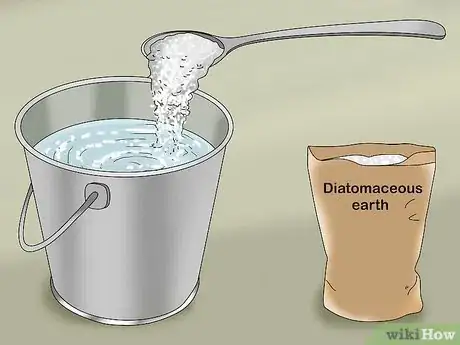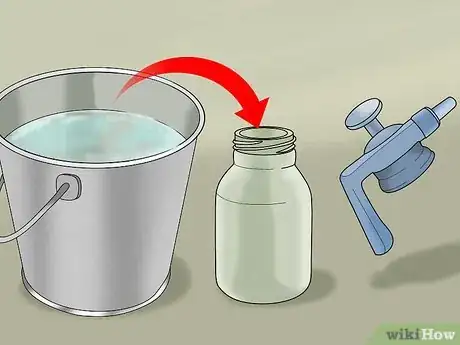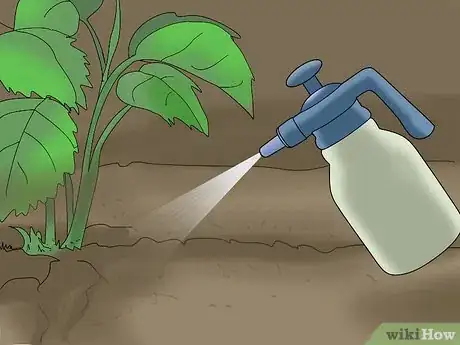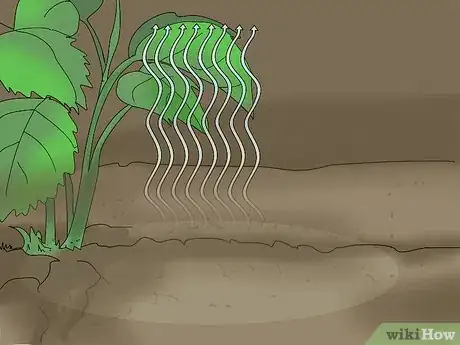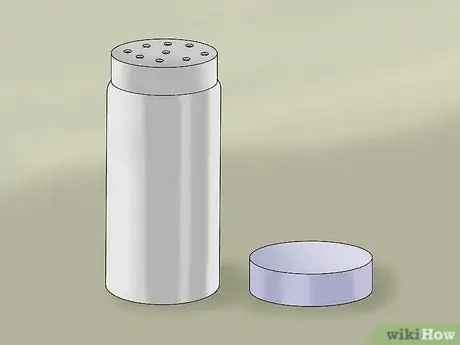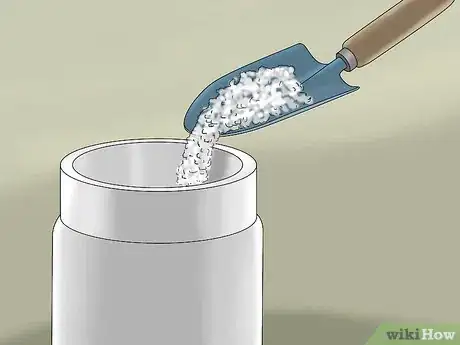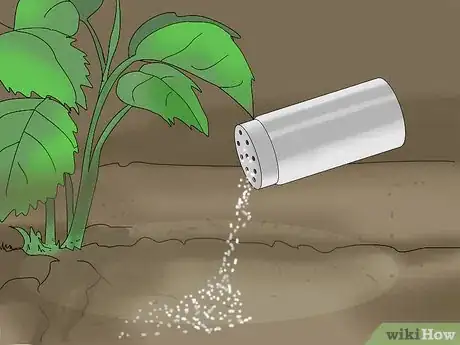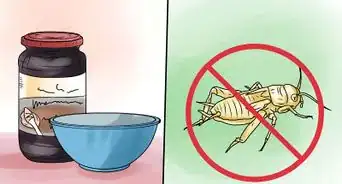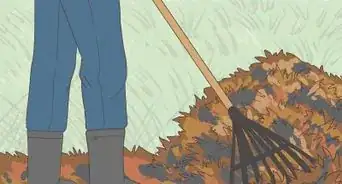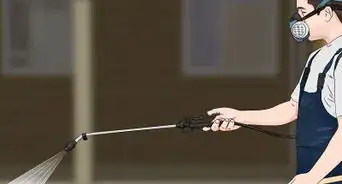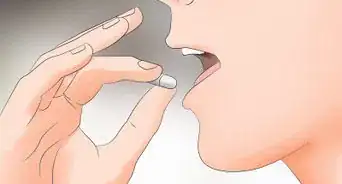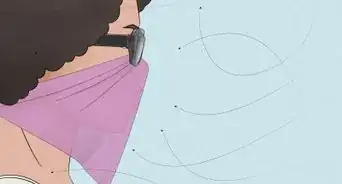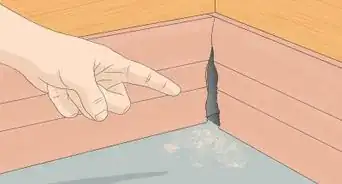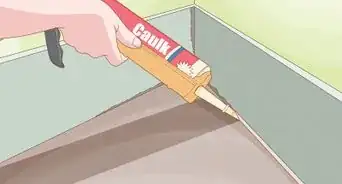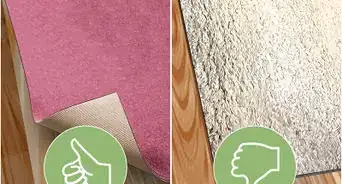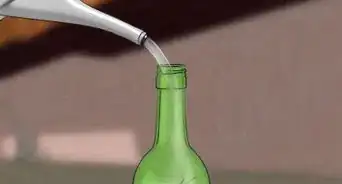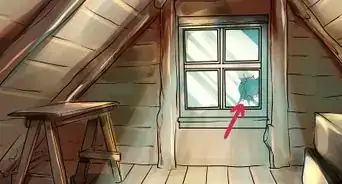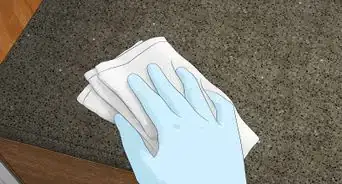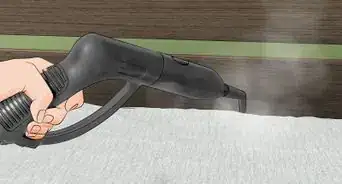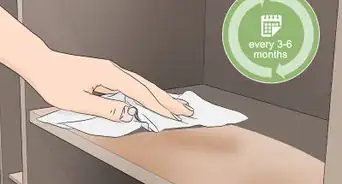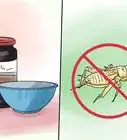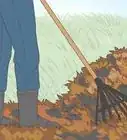This article was co-authored by Chris Parker. Chris Parker is the Founder of Parker Eco Pest Control, a sustainable pest control service in Seattle, Washington. With over seven years of experience, Chris specializes in Integrated Pest Management and doesn’t use any chemicals for pest removal. He offers removal services for ants, rodents, fleas, spiders, wasps, and more. Chris is a certified Commercial Pesticide Applicator in Washington State and received his bachelor’s from the University of Washington.
This article has been viewed 63,987 times.
Diatomaceous earth is a mineral powder that can help you get rid of fleas, cockroaches, ants, and dust mites. You can apply it in wet or dry form—applying it in wet form allows it to cling to a surface easier, especially in the wind. Whether you're applying it as a dry powder or mixing it with water to spray it on your yard, avoid breathing it in and only apply it to spots that need protecting.
Steps
Using Diatomaceous Earth Safely
-
1Avoid breathing in or touching the dust particles. Diatomaceous earth is a fine powder, which can irritate your throat if you breathe a lot of it in. Wear a face mask to avoid inhaling the powder, and wear gloves on your hands so that the powder won’t dry out your skin.[1]
- If you don’t have a face mask, you can also wear a bandana or towel over your mouth to keep out the dust.
-
2Use diatomaceous earth on plants that truly need it. Instead of spreading the powder all over your yard, only use it on plants that are being eaten or really need the protection. This will help protect beneficial insects that you might have in your yard, such as bees.[2]
- Apply it close to the ground, and avoid spreading it over flowers that are in bloom so that you don’t harm bees.
Advertisement -
3Apply the powder in the early morning or evening for best results. There’s often morning dew on your plants during this time, which will make the powder adhere much easier. It’s also a great time to spread the powder because bees and other beneficial insects aren’t as likely to be out and about at that time.[3]
-
4Spread diatomaceous earth on non-windy days. Since it’s a fine powder, diatomaceous earth blows away very easily. To prevent your application from blowing around your yard, or out of your yard completely, wait until it’s a calm day outside to spread it.[4]
- If you have to spread it in light wind, opt for using a wet application to help keep the diatomaceous earth in place.
-
5Reapply diatomaceous earth after heavy wind or rain. A rainstorm or super windy day is likely to wash or blow away the diatomaceous earth, especially if it was spread in powder form. If it rains or is windy, wait until the weather dies down a bit and reapply just as you did the first time.
- It's okay to apply diatomaceous earth when the ground is wet after a rain shower, just make sure it's not going to rain heavily afterwards.
Spreading Wet Diatomaceous Earth Outside
-
1Use wet diatomaceous earth to ensure it sticks to the plants. If you're worried about the powder getting picked up by the wind, spreading a wet application over the intended area will help it attach to the plants and ground. Wet applications of the powder are also the best option when you're treating a larger area.
- For example, if you need to use diatomaceous earth on your entire lawn, using a large spray bottle will allow you to easily spread it.
-
2Mix 4 tablespoons (59 ml) of diatomaceous earth with 1 gallon (3.8 L) of water. Use a water jug, bucket, or similar container to hold the contents. Pour in 4 tablespoons (59 ml) of diatomaceous earth for every gallon (3.8 L) of water. Mix these together thoroughly until the powder dissolves.[5]
- It’s easiest to pour the 4 tablespoons (59 ml) into a jug of water, seal the lid on tightly, and then shake the container to get the powder to dissolve.
-
3Fill a spray bottle or garden pump sprayer with the mixture. If you only need to apply diatomaceous earth to a specific spot, a small spray bottle is the perfect application option. For spraying bigger areas, trying using a garden pump sprayer filled with the mixture.[6]
- If you're treating 1 or 2 plants, you might use a small spray bottle.
- If you're treating a larger area, such as your entire flower bed or garden, you'd want to use a garden pump sprayer.
-
4Spray the plants or lawn section with a fine layer of diatomaceous earth. Use your spray bottle or pump to apply a thin layer of diatomaceous earth to all sides of the plants. The plants and other necessary areas should be wet, but not dripping.[7]
- If you’re applying it to leaves, remember to spray the bottom of the leaves as well.
-
5Allow the spray to dry completely before it starts working. Diatomaceous earth doesn’t work while it’s still wet—it will need to completely dry first. Once the water evaporates, the powder will be left on the plants, providing a protective barricade against any pests.[8]
Using Dry Diatomaceous Earth
-
1Apply dry diatomaceous earth quickly for smaller areas. Spreading the powder in dry form is much quicker for smaller areas, as you don't have to mix it with water. You'll apply a thin layer of the powder to the spots needed, making sure you don't layer it on too thick and it doesn't clump. The plants should be able to receive sunlight and grow properly.
-
2Use a shaker to apply the dry powder. You can either buy one specifically for this purpose, or you can create your own using an old spice shaker or plastic coffee can. Punch 5-10 holes in the container using a nail to allow the powder to fall through.[9]
- You can also use a garden duster or flour sifter.
- Sometimes you can even buy bags of diatomaceous earth that come with a duster built in.
- Find products specifically for spreading diatomaceous earth powder at your local garden store or online.
-
3Fill the shaker with the diatomaceous earth powder. Use a small shovel to transport the powder into the shaker instead of pouring the powder directly from the bag into the container—this will help prevent dust from flying up. Fill the shaker up with as much powder as you think you might need to cover the intended area.[10]
-
4Sprinkle the powder over the plants using the shaker. Spread diatomaceous earth over the plants and other sections of your lawn that truly need it—remember to avoid haphazardly spreading it everywhere. Shake it onto both sides of the leaves if the leaves are damaged, leaving behind a thin layer.[11]
- Applying the powder around the base of your garden or right at the soil level will help prevent crawling insects from eating away at your plants.
Community Q&A
-
QuestionHow long do I leave diatomaceous earth on the lawn after application before watering the lawn?
 Community AnswerWhether you have used the wet or dry method of spreading your diatomaceous earth outdoors, it is susceptible to moisture and reapplication is necessary after each rainfall or sprinkler system. Rule of thumb: If you can't SEE the powder, reapply every 3 days or so.
Community AnswerWhether you have used the wet or dry method of spreading your diatomaceous earth outdoors, it is susceptible to moisture and reapplication is necessary after each rainfall or sprinkler system. Rule of thumb: If you can't SEE the powder, reapply every 3 days or so. -
QuestionI want to treat lawn that my dog plays on, is DE safe for animals?
 7ornado.alCommunity AnswerDE comes in two forms: non food-grade and food-grade. Non food-grade is safe when applied to a lawn, but any DE that is to be ingested by pets should be food-grade. It is made up of the skeletal structures of tiny organisms whose spines are only harmful to small and delicate parasites. However DE that isn't food-grade might contain chemicals from processing that can harm pets.
7ornado.alCommunity AnswerDE comes in two forms: non food-grade and food-grade. Non food-grade is safe when applied to a lawn, but any DE that is to be ingested by pets should be food-grade. It is made up of the skeletal structures of tiny organisms whose spines are only harmful to small and delicate parasites. However DE that isn't food-grade might contain chemicals from processing that can harm pets. -
QuestionMy dog was recently diagnosed with hookworms and DE was recommended for spots where feces was left over 24 hours. How do I know it's been effective? Should I spread it all over the lawn instead?
 Community AnswerDo not treat any area your dog/s go in with anything. You must treat your actual dog. Then, pick up and dispose of the feces immediately, as the dog got this by ingesting feces. Wash your hands well after treating the dog or collecting feces.
Community AnswerDo not treat any area your dog/s go in with anything. You must treat your actual dog. Then, pick up and dispose of the feces immediately, as the dog got this by ingesting feces. Wash your hands well after treating the dog or collecting feces.
References
- ↑ http://www.theprairiehomestead.com/2015/07/diatomaceous-earth-garden.html
- ↑ http://www.theprairiehomestead.com/2015/07/diatomaceous-earth-garden.html
- ↑ http://www.theprairiehomestead.com/2015/07/diatomaceous-earth-garden.html
- ↑ http://www.theprairiehomestead.com/2015/07/diatomaceous-earth-garden.html
- ↑ https://www.essentialhomeandgarden.com/how-to-apply-diatomaceous-earth/
- ↑ https://www.maximumyield.com/organic-pest-control-diatomaceous-earth-how-to-apply-it/2/2886
- ↑ https://www.maximumyield.com/organic-pest-control-diatomaceous-earth-how-to-apply-it/2/2886
- ↑ https://www.maximumyield.com/organic-pest-control-diatomaceous-earth-how-to-apply-it/2/2886
- ↑ http://www.theprairiehomestead.com/2015/07/diatomaceous-earth-garden.html
About This Article
Diatomaceous earthis a mineral powder that can be used to get rid of fleas, cockroaches, ants, and dust mites from your garden. It can cause irritation if it's inhaled, so always wear a face mask and gloves when you apply it. Only apply the powder to plants that are being eaten so you don't kill beneficial insects. Apply the powder when it’s not windy so it doesn’t blow away. If your plants are dry, you can help the diatomaceous earth stick to them by mixing it with water in a spray bottle. Otherwise, sprinkle the powder from an old spice shaker or make your own shaker. If there’s heavy wind or rain after you apply the powder, you might need to apply more once the weather’s settled. For more tips, including how to make a shaker to sprinkle dry diatomaceous earth onto your plants, read on!
